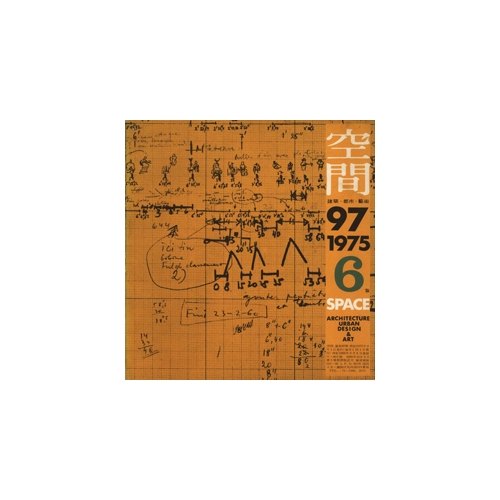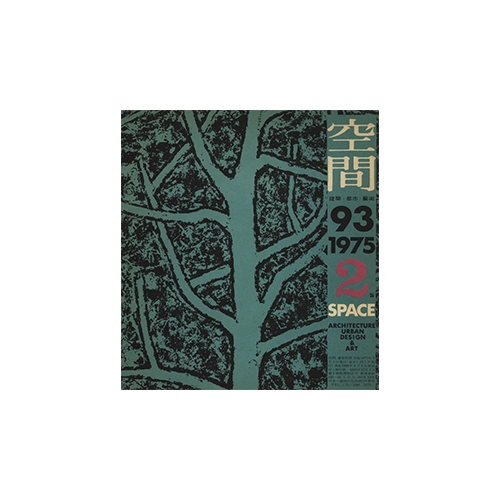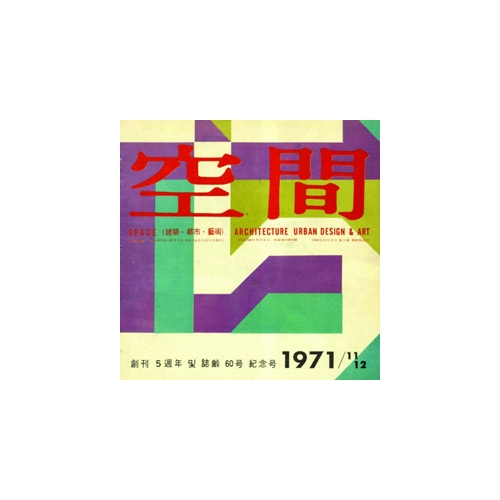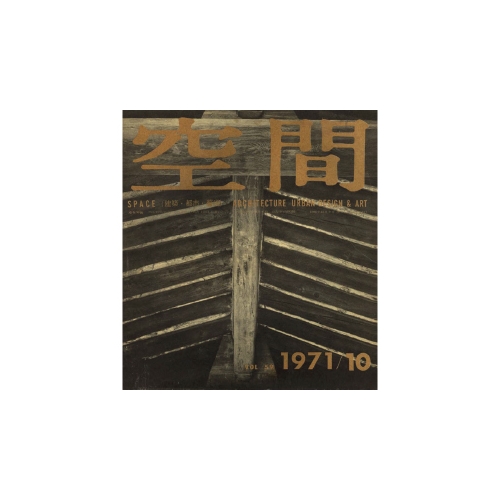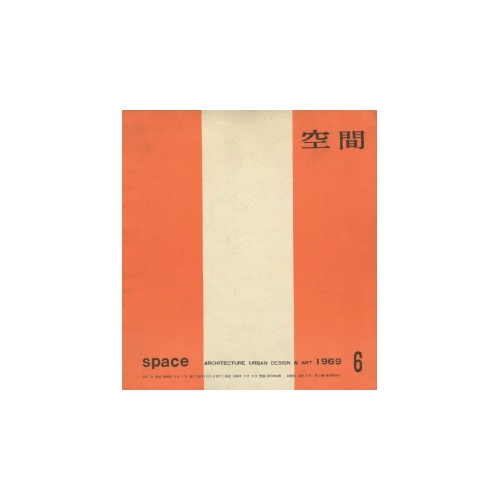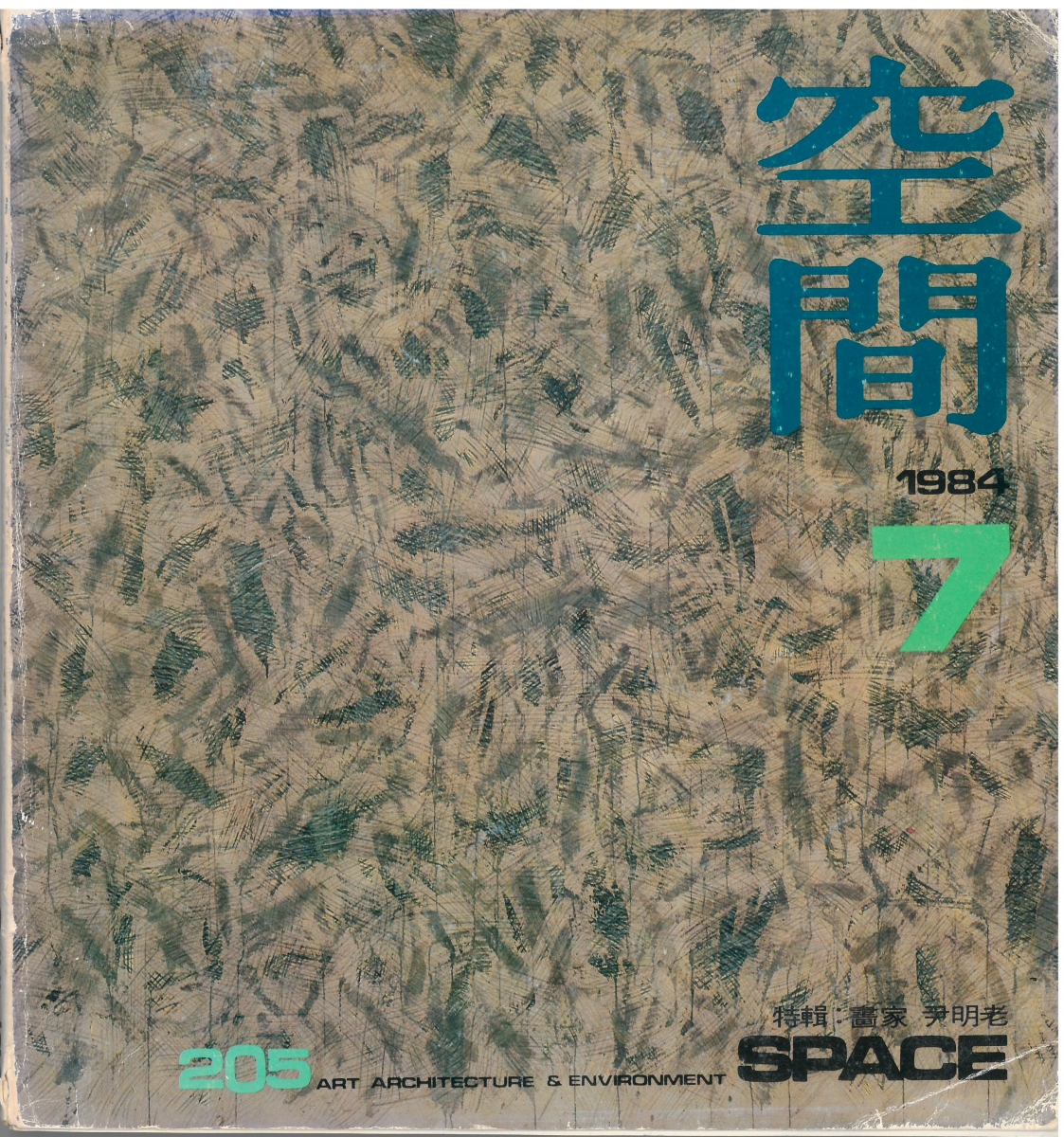
The cover of SPACE No. 205 (July 1984)
In SPACE No. 205 (July 1984) a special feature, ‘Architectural Criticism’, held prominence. The opening article of the section, ‘In Expectation of Architectural Criticism’, was by first-generation architect and critic Song Min Ku (1920 – 2010). Making reference to Umberto Eco’s semiotic theory, which was widely discussed in the 1980s and considered in connection with postmodernism’s privileging of ‘polysemy’, Song Min Ku underlined a contemporary dilemma that ‘we who indulge in rationalism hesitate to accept them’. The author, who was an early adopter of this critical line, failed to escape from the restrictions of his time in his conclusion. Querying the source of a universal basis for critical value judgments, he asserted that ‘the prerequisite for the value judgment in criticism should be, at least, the promotion of national culture’.▼1
This special feature was also published in reaction to the consequences of a design competition for The Independence Hall of Korea held in the previous year. A series of issues concerning tradition and ‘Koreanity’, beginning with regional flagship national museums such as Buyeo National Museum and National Folk Museum (presently the National Folk Museum of Korea) in the mid-late 1960s, to the Sejong Cultural Center (presently Sejong Center for the Performing Arts) and the National Theater of Korea in the 1970s (which were concluded in a rather regressive manner rather than their design language simplified). These cultural facilities were to be huge tiled roof buildings, as originally commissioned by the client, and the special feature section was republished to re-examine situations such as these as resulting from an ‘absence of criticism’. In this situation, Song’s diagnosis was not enough to set up a new discussion or to embark upon a new debate. This is because, as may have already been assumed from the discussion of ‘Koreanity’, which continues to be brought up from time to time, the complex problems that haunt the reproduction and presentation of modern architecture in Korea cannot be solved without conisdering a much more complex and urgent issue; ‘race’. Although he added weight to each of the new authors, this was not enough to discern the conditions criticism faced in the 1980s.
In fact, the voice leading this special feature was not his own. Kim Kyong Soo (1951 –) was the editor of this series, offering a sharp critique of historical determinism in his ‘On the Problem of Wissenschaftlichkeit in Architectural History and Criticism’, which was published about a year ago in March 1983.▼2 In his early thirties at the time of publication, this was an attempt to revolutionise architectural criticism. By challenging those who commented on an absence of critical engagement, he introduced this special feature by stating, ‘It is positive that there is recognition of the lack of critical engagement across our architectural scene, but this cannot be said to be productive in itself’.▼3 He diagnosed a particular condition: there was no functioning critical sphere, rather than no criticism itself, and the function and ambitions of criticism had not been clearly outlined or appreciated. This anticipated his move toward a more earnest critical practice by taking the role of editor of Architecture & Environment(presently C3 KOREA), an architectural journal founded two months later in September 1984. The article announces the birth of a critic in his 30s, taking aim at a culture without ‘any decent architectural magazine’ or critical outlet, which has a certain irony in that the article was published in SPACE, a magazine that had already reached 205 issues at that time.▼4
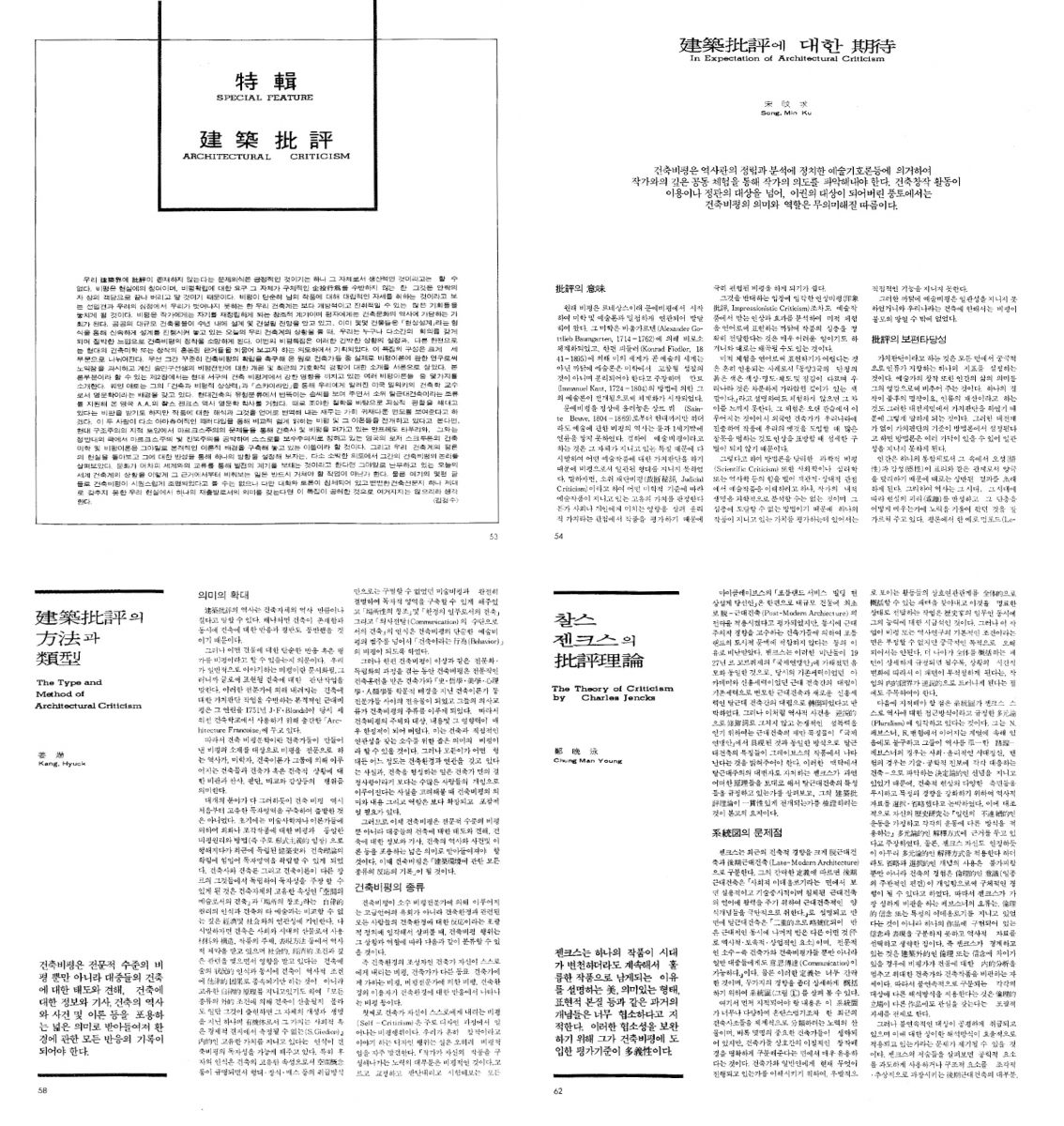
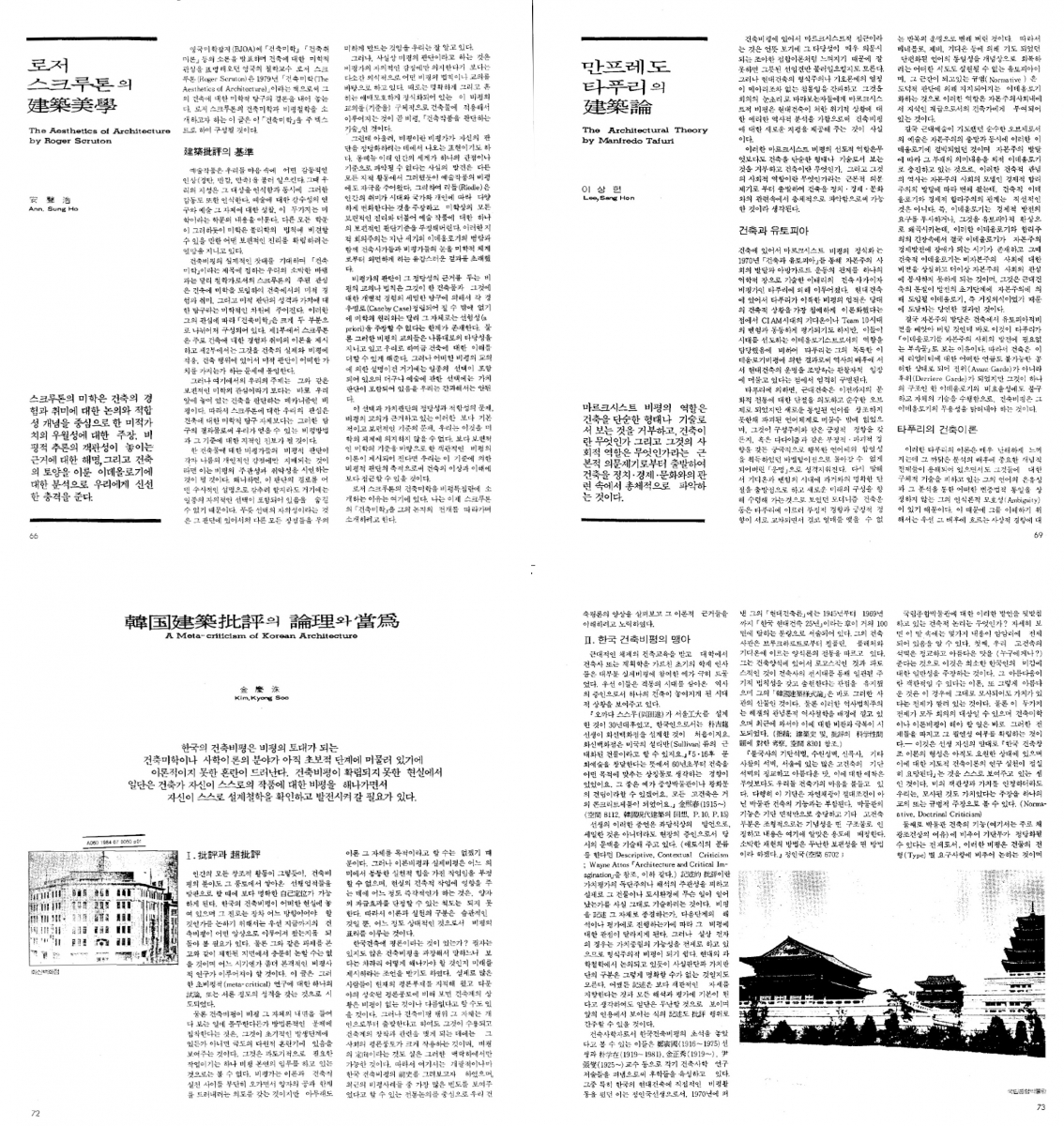
In line with this opinion, following reviews of existing critical positions and introductions to new theories by authors junior to him, the special feature ended with Kim Kyong Soo’s article. Hyuk Khang contributed ‘The Type and Method of Architectural Criticism’, which classified and introduced types and methodologies in architectural criticism, while Ahn Sung Ho introduced ‘The Aesthetics of Architecture by Roger Scruton’, Mann-Young Chung ‘The Theory of Criticism by Charles Jencks’, and Sanghun Lee ‘The Architectural Theory by Manfredo Tafuri’. In every aspect, the authors introduced relatively nascent theories, and their treatment seems symptomatic. Hyuk Khang, Mann-Young Chung, and Sanghun Lee, who have been active as representative writers in the field of architectural history and theory, heralded a shift in the long history and genealogy of criticism as one of the first starting points for the magazine. On the other hand, this feature also instigated the practice of summarising and introducing theories popular in the United States but not yet translated into Korean at the time.▼5 In fact, the theories introduced in this special issue were almost entirely unavailable in Korea. Roger Scruton’s The Aesthetics of Architecture was published in 1985, and translated by Kim Kyong Soo, but it was only in 1987 when Charles Jencks’ Modern Movements in Architecture was translated into Korean, and 1991 when Manfredo Tafuri’s Architecture and Utopia: Design and Capitalist Development found its Korean audience.▼6
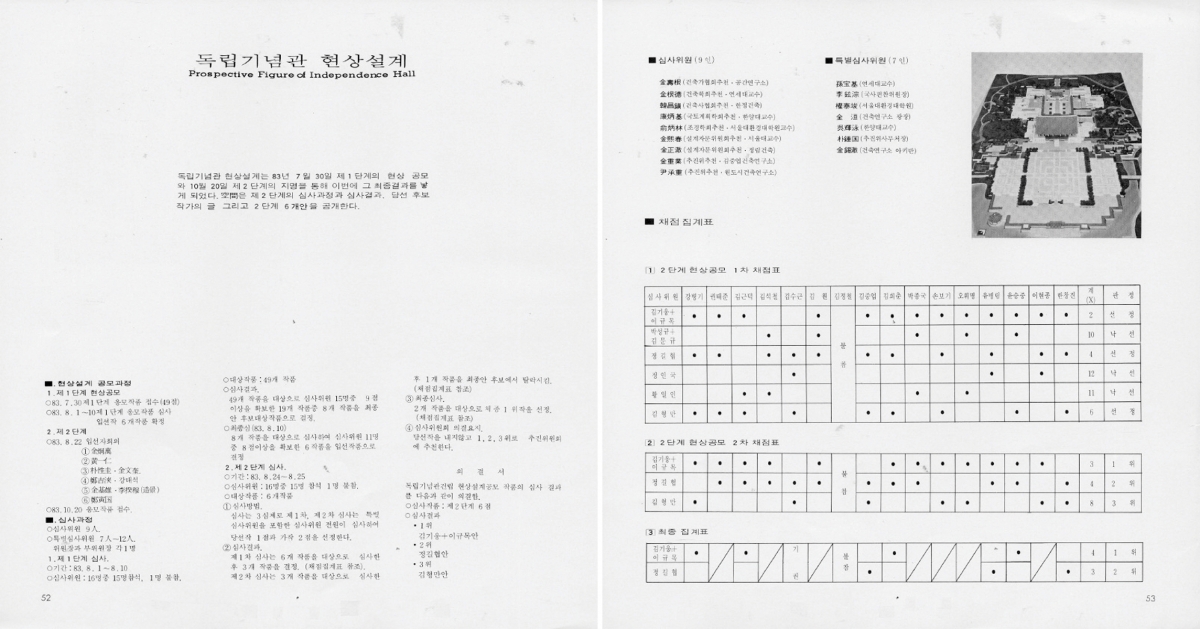
‘Prospective Figure of Independence Hall’, SPACE No. 199 (Jan. 1984), pp. 53 – 54.
In the midst of skepticism about modernism, as a consequence of the shift in generations, and recurring controversy over a revival of a more traditional style, Kim Kyong Soo tried to reinvestigate the basis of his criticism. In ‘A Meta-criticism of Korean Architecture’, the final article in the special feature, he attempted a work of meta-criticism that would analyse the debate concerning tradition conducted by architects and historians such Yoon Il-joo, Kim Hong-sik, Kim Chung-up, and Um Duk-Moon from the point of view of its critical language. This unusual critique of critique was concluded in a rather simple way. Kim Kyong Soo, who was aware that there could be no logic or method to end the traditional debate, came to the conclusion that it was necessary to cultivate greater knowledge of Korean traditional architecture and to better elaborate the language of criticism, in order to increase the writing of analytical articles that would question the foundations of a critical or design position instead of making dogmatic arguments.
However, in this article, he neglects to ask why young architects in their 40s at that time had returned to a position in support of a monument imitating traditional style and why they felt they had to do so.In spite of a time difference of 37 years, these articles continue to have a strange familiarity. This is because the mechanism of criticism and the anxiety surrounding criticism remain with us, despite differences in the protagonists, target buildings, and Western theories as tools. A sense of fixity regarding criticism’s governing aims has been postponed again and again amid the shifts in theories and the notion that criticism hardly provides ‘a creative opportunity for writers to re-establish themselves, and an opportunity for reviewers to participate in the history of architectural culture’.▼8 Given our present situation of pluralistic theories and the transformations in architectural production methods, the possibility of criticism has continued to shrink. However, in vast record of critical debate that continues to accumulate in the SPACE archive, I hope we may find new possibilities for criticism. In other words, this would be a criticism that does not rely on individual building reviews, but a criticism forged from the history of critical discourse itself. Criticism can save the past even if it cannot reveal the future. (written by Park Junghyun)
In our next issue, Suh Jaewon will cover ‘Residence for Mr. Poitress’, which featured in SPACE No. 58 (Sep. 1971).
▼
1. Song Min Ku, ‘In Expectation of Architectural Criticism’, SPACE No. 205 (July 1984), p. 57.
2. SPACE No. 189 (Mar. 1983), pp. 81 – 87.
3. Kim Kyong Soo, ‘Special Feature’, SPACE No. 205, p. 53.
4. Ibid.
5. SPACE began publishing a series of articles entitled ‘Description of Modern Architecture Literature’ from No. 199 (Jan. 1984). Hyuk Khang and Mann-Young Chung also authored these articles.
6. The first editions of the original books were published as follows: Roger Scruton, The Aesthetics of Architecture (Princeton: Princeton University Press, 1979); Charles Jencks, Modern Movements in Architecture (NY: Anchor Press, 1973); Manfredo Tafuri, Progetto e utopia: Architettura e sviluppo capitalistico (Bari; Laterza, 1973). The English translation of Tafuri’s book is as follows: Architecture and Utopia: Design and Capitalist Development, trans. Barbara Luigia La Penta (Cambridge, MA: MIT Press, 1976).
7. ‘Prospective Figure of the Independence Hall’, SPACE No. 199, p. 53.
8. Kim Kyong Soo, op. cit.





